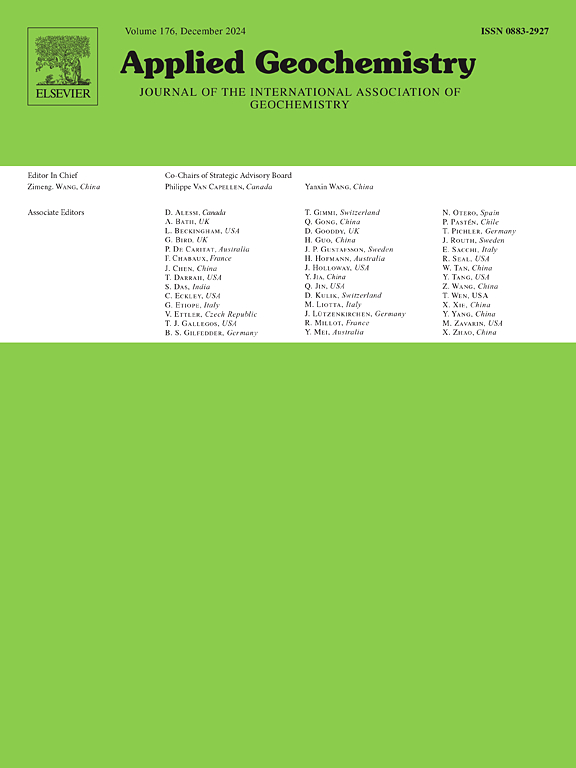重度石漠化地区洞穴水的同位素信号及其环境意义
IF 3.4
3区 地球科学
Q1 GEOCHEMISTRY & GEOPHYSICS
引用次数: 0
摘要
洞穴系统是反演石漠化的重要工具。然而,由于气候系统的复杂性、洞穴沉积物积累的长期性以及喀斯特地质过程的时空异质性,使得原始信号在传输过程中会发生改变。本文对贵州喀斯特溶洞系统大气降水、植物水、土壤水、洞穴滴水和地下河流出水的同位素值和环境参数进行了逐月的原位监测,详细探讨了水分迁移和变化过程。结果表明,降水对洞穴微环境的物理化学性质具有显著的调节作用,洞穴水滴表现为Ca2+•Mg2+- hco3 -水化学类型。大气降水是研究区的主要水源,除植物水同位素外,其余水体均具有季节变化特征。在传播过程中,溶洞系统水体的滞后时间差异较大,从2 d到1年不等,这与典型岩溶景观区水分的蓄积和释放机制密切相关。水汽源的时空分布、温度和降水的季节变化对研究区水体同位素变化有显著影响。总体而言,本研究对贵州溶洞水体迁移转化过程进行了系统研究,为提高对喀斯特地区水文过程和气候变化的认识提供了新的途径和视角。本文章由计算机程序翻译,如有差异,请以英文原文为准。
Isotopic signaling and environmental significance of cave waters in a heavily rocky desertification area
Cave systems are important tools for inversion of rock desertification. However, the complexity of the climate system, the long-term nature of cave sediment accumulation and the spatial and temporal heterogeneity of karst geologic processes allow the original signals to be altered during transmission. In this work, the isotopic values and environmental parameters of atmospheric precipitation, plant water, soil water, cave drip water and underground river outflow water in the Guizhou karst cave system are monitored in situ on a monthly scale, and the processes of water migration and change are explored in detail. The results showed that precipitation has a significant regulatory effect on the physicochemical properties of the cave microenvironment, and cave drip water exhibits a Ca2+•Mg2+-HCO3- hydrochemical type. Atmospheric precipitation is the main water source in the study area, except for plant water isotopes, the remaining water bodies are characterized by seasonal changes. The lag times of the water bodies in the cave system significantly differ during the transmission process, ranging from 2 d to 1 year, which is closely related to the mechanism of water accumulation and release in typical karst landscape areas. The spatial and temporal distributions of water vapor sources, as well as seasonal variations in temperature and precipitation, significantly influence the isotopic changes in water bodies in the study area. Overall, this study provides a systematic study on the migration and transformation process of water bodies in Guizhou karst caves, which provides a new approach and perspective for an improved understanding of hydrological processes and climate change in karst areas.
求助全文
通过发布文献求助,成功后即可免费获取论文全文。
去求助
来源期刊

Applied Geochemistry
地学-地球化学与地球物理
CiteScore
6.10
自引率
8.80%
发文量
272
审稿时长
65 days
期刊介绍:
Applied Geochemistry is an international journal devoted to publication of original research papers, rapid research communications and selected review papers in geochemistry and urban geochemistry which have some practical application to an aspect of human endeavour, such as the preservation of the environment, health, waste disposal and the search for resources. Papers on applications of inorganic, organic and isotope geochemistry and geochemical processes are therefore welcome provided they meet the main criterion. Spatial and temporal monitoring case studies are only of interest to our international readership if they present new ideas of broad application.
Topics covered include: (1) Environmental geochemistry (including natural and anthropogenic aspects, and protection and remediation strategies); (2) Hydrogeochemistry (surface and groundwater); (3) Medical (urban) geochemistry; (4) The search for energy resources (in particular unconventional oil and gas or emerging metal resources); (5) Energy exploitation (in particular geothermal energy and CCS); (6) Upgrading of energy and mineral resources where there is a direct geochemical application; and (7) Waste disposal, including nuclear waste disposal.
 求助内容:
求助内容: 应助结果提醒方式:
应助结果提醒方式:


